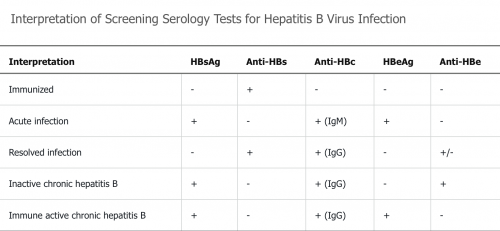Différences entre versions de « Hépatites virales »
De médecine.top
| Ligne 6 : | Ligne 6 : | ||
! | ! | ||
! HBsAg | ! HBsAg | ||
| + | Infection aiguë ou chronique | ||
! anti-HBs | ! anti-HBs | ||
| + | Infection résolue/vaccination | ||
! anti-HBc | ! anti-HBc | ||
| + | Infection actuelle ou passée | ||
! HBeAg | ! HBeAg | ||
| + | Réplication active | ||
! anti-HBe | ! anti-HBe | ||
| + | Infection inactive ou mutant | ||
! HBV DNA | ! HBV DNA | ||
! ALAT | ! ALAT | ||
! Prise en charge | ! Prise en charge | ||
| − | |||
| − | |||
| − | |||
| − | |||
| − | |||
| − | |||
| − | |||
| − | |||
| − | |||
| − | |||
|- | |- | ||
| style="font-weight:bold;" | Phase immunotolérante | | style="font-weight:bold;" | Phase immunotolérante | ||
Version du 18 avril 2020 à 13:11
Hépatite B
Infection chronique à HBV
| HBsAg
Infection aiguë ou chronique |
anti-HBs
Infection résolue/vaccination |
anti-HBc
Infection actuelle ou passée |
HBeAg
Réplication active |
anti-HBe
Infection inactive ou mutant |
HBV DNA | ALAT | Prise en charge | |
|---|---|---|---|---|---|---|---|---|
| Phase immunotolérante
Âge < 30 ans |
+ | + | - | > 1 million | Normal | Absence d'inflammation hépatique.
Suivi ALAT +/- alpha-FP/US. Exceptions: patients >40 ans, virémie >1 mio ET inflammation et fibrose | ||
| Phase immunoréactive | + | - | + (IgG) OK ??? | + | ?? | > 20 000 IU/ml | Augmentées | Inflammation et fibrose
Traitement nécessaire. |
| + | - | + (IgG) OK ??? | - | ?? | > 2000 IU/ml | |||
| Porteur inactif de l'hépatite B chronique (immune control) | + | - | + (IgG) OK ??? | - | + | < 2000 IU/ml | Normal | Pas d'inflammation, fibrose variable
Suivi de l'HBV DNA 3-4x/an |
| Réactivation | +/- | + | Augmentation par rapport à la virémie de base | Augm à 3x >100 U/l | ||||
| Hépatite B résolue | - | + | + (IgG) | - | +/- | - | Normal | CAVE si immunosupression |
